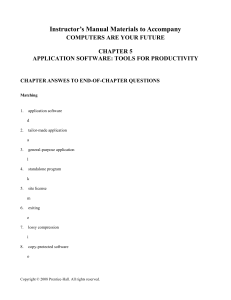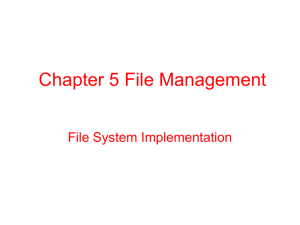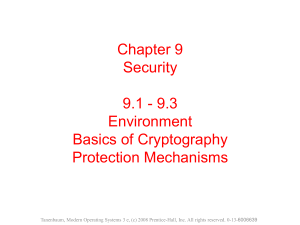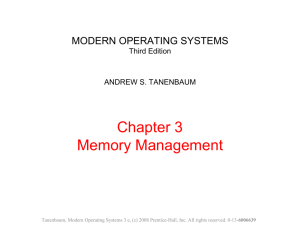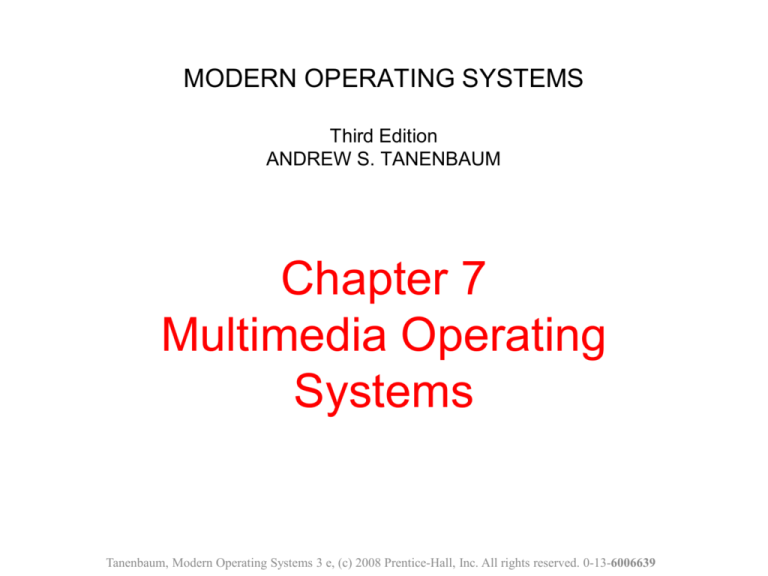
MODERN OPERATING SYSTEMS
Third Edition
ANDREW S. TANENBAUM
Chapter 7
Multimedia Operating
Systems
Tanenbaum, Modern Operating Systems 3 e, (c) 2008 Prentice-Hall, Inc. All rights reserved. 0-13-6006639
Introduction To Multimedia (1)
Figure 7-1. Video on demand using different
local distribution technologies. (a) ADSL.
Tanenbaum, Modern Operating Systems 3 e, (c) 2008 Prentice-Hall, Inc. All rights reserved. 0-13-6006639
Introduction To Multimedia (2)
Figure 7-1. Video on demand using different
local distribution technologies. (b) Cable TV.
Tanenbaum, Modern Operating Systems 3 e, (c) 2008 Prentice-Hall, Inc. All rights reserved. 0-13-6006639
Introduction To Multimedia (3)
Key characteristics of multimedia:
1. Multimedia uses extremely high data
rates.
2. Multimedia requires real-time playback.
Tanenbaum, Modern Operating Systems 3 e, (c) 2008 Prentice-Hall, Inc. All rights reserved. 0-13-6006639
Introduction To Multimedia (4)
Figure 7-2. Some data rates for multimedia and high-performance
I/O devices. Note that 1 Mbps is 106 bits/sec
but 1 GB is 230 bytes.
Tanenbaum, Modern Operating Systems 3 e, (c) 2008 Prentice-Hall, Inc. All rights reserved. 0-13-6006639
Multimedia Files
Figure 7-3. A movie may consist of several files.
Tanenbaum, Modern Operating Systems 3 e, (c) 2008 Prentice-Hall, Inc. All rights reserved. 0-13-6006639
Video Encoding
Figure 7-4. The scanning pattern used for NTSC
video and television.
Tanenbaum, Modern Operating Systems 3 e, (c) 2008 Prentice-Hall, Inc. All rights reserved. 0-13-6006639
Audio Encoding
Figure 7-5. (a) A sine wave. (b) Sampling the sine wave.
(c) Quantizing the samples to 4 bits.
Tanenbaum, Modern Operating Systems 3 e, (c) 2008 Prentice-Hall, Inc. All rights reserved. 0-13-6006639
The JPEG Standard (1)
Figure 7-6. (a) RGB input data. (b) After block preparation.
Tanenbaum, Modern Operating Systems 3 e, (c) 2008 Prentice-Hall, Inc. All rights reserved. 0-13-6006639
The JPEG Standard (2)
Figure 7-7. (a) One block of the Y matrix.
(b) The DCT coefficients.
Tanenbaum, Modern Operating Systems 3 e, (c) 2008 Prentice-Hall, Inc. All rights reserved. 0-13-6006639
The JPEG Standard (3)
Figure 7-8. Computation of the quantized DCT coefficients.
Tanenbaum, Modern Operating Systems 3 e, (c) 2008 Prentice-Hall, Inc. All rights reserved. 0-13-6006639
The JPEG Standard (4)
Figure 7-9. The order in which the quantized
values are transmitted.
Tanenbaum, Modern Operating Systems 3 e, (c) 2008 Prentice-Hall, Inc. All rights reserved. 0-13-6006639
The MPEG Standard (1)
Three types of MPEG-2 frames processed
by the viewing program:
1. I (Intracoded) frames: Self-contained
JPEG-encoded still pictures.
2. P (Predictive) frames: Block-by-block
difference with the last frame.
3. B (Bidirectional) frames: Differences with
the last and next frame.
Tanenbaum, Modern Operating Systems 3 e, (c) 2008 Prentice-Hall, Inc. All rights reserved. 0-13-6006639
The MPEG Standard (2)
Figure 7-10. Three consecutive video frames.
Tanenbaum, Modern Operating Systems 3 e, (c) 2008 Prentice-Hall, Inc. All rights reserved. 0-13-6006639
Audio Compression (1)
Figure 7-11. (a) A binary signal and its
root-mean-square Fourier amplitudes.
Tanenbaum, Modern Operating Systems 3 e, (c) 2008 Prentice-Hall, Inc. All rights reserved. 0-13-6006639
Audio Compression (2)
Figure 7-11. (b)–(e) Successive approximations
to the original signal.
Tanenbaum, Modern Operating Systems 3 e, (c) 2008 Prentice-Hall, Inc. All rights reserved. 0-13-6006639
Audio Compression (3)
Figure 7-11. (b)–(e) Successive approximations
to the original signal.
Tanenbaum, Modern Operating Systems 3 e, (c) 2008 Prentice-Hall, Inc. All rights reserved. 0-13-6006639
Audio Compression (4)
Figure 7-12. (a) The threshold of audibility as a
function of frequency. (b) The masking effect.
Tanenbaum, Modern Operating Systems 3 e, (c) 2008 Prentice-Hall, Inc. All rights reserved. 0-13-6006639
Audio Compression (5)
Possible sampling configurations:
1. Monophonic (a single input stream).
2. Dual monophonic (e.g., an English and a
Japanese soundtrack).
3. Disjoint stereo (each channel compressed
separately).
4. Joint stereo (interchannel redundancy fully
exploited).
Tanenbaum, Modern Operating Systems 3 e, (c) 2008 Prentice-Hall, Inc. All rights reserved. 0-13-6006639
General Real-Time Scheduling
Figure 7-13. Three periodic processes, each displaying a movie.
The frame rates and processing requirements per frame are
different for each movie.
Tanenbaum, Modern Operating Systems 3 e, (c) 2008 Prentice-Hall, Inc. All rights reserved. 0-13-6006639
Rate Monotonic Scheduling (1)
Required conditions for RMS:
1. Each periodic process must complete within its
period.
2. No process is dependent on any other
process.
3. Each process needs same amount of CPU
time on each burst.
4. Nonperiodic processes have no deadlines.
5. Process preemption occurs instantaneously
and with no overhead.
Tanenbaum, Modern Operating Systems 3 e, (c) 2008 Prentice-Hall, Inc. All rights reserved. 0-13-6006639
Rate Monotonic Scheduling (2)
Figure 7-14. An example of RMS and EDF real-time scheduling.
Tanenbaum, Modern Operating Systems 3 e, (c) 2008 Prentice-Hall, Inc. All rights reserved. 0-13-6006639
Earliest Deadline First Scheduling
Figure 7-15. Another example of real-time
scheduling with RMS and EDF.
Tanenbaum, Modern Operating Systems 3 e, (c) 2008 Prentice-Hall, Inc. All rights reserved. 0-13-6006639
Multimedia File System Paradigms
Figure 7-16. (a) A pull server. (b) A push server.
Tanenbaum, Modern Operating Systems 3 e, (c) 2008 Prentice-Hall, Inc. All rights reserved. 0-13-6006639
Near Video on Demand
Figure 7-17. Near video on demand has a new stream
starting at regular intervals, in this example
every 5 minutes (9000 frames).
Tanenbaum, Modern Operating Systems 3 e, (c) 2008 Prentice-Hall, Inc. All rights reserved. 0-13-6006639
Near Video on Demand with VCR
Functions (1)
Figure 7-18. (a) Initial situation. (b) After a rewind to 12 min
Tanenbaum, Modern Operating Systems 3 e, (c) 2008 Prentice-Hall, Inc. All rights reserved. 0-13-6006639
Near Video on Demand with VCR
Functions (2)
Figure 7-18. (c) After waiting 3 min.
(d) After starting to refill the buffer. (e) Buffer full.
Tanenbaum, Modern Operating Systems 3 e, (c) 2008 Prentice-Hall, Inc. All rights reserved. 0-13-6006639
Placing a File on a Single Disk
Figure 7-19. Interleaving video, audio, and text in a single
contiguous file per movie.
Tanenbaum, Modern Operating Systems 3 e, (c) 2008 Prentice-Hall, Inc. All rights reserved. 0-13-6006639
Two Alternative File
Organization
Strategies (1)
Figure 7-20. Noncontiguous
movie storage. (a) Small
disk blocks.
Tanenbaum, Modern Operating Systems 3 e, (c) 2008 Prentice-Hall, Inc. All rights reserved. 0-13-6006639
Two Alternative File
Organization
Strategies (2)
Figure 7-20.
Noncontiguous
movie storage
(b) Large disk
blocks.
Tanenbaum, Modern Operating Systems 3 e, (c) 2008 Prentice-Hall, Inc. All rights reserved. 0-13-6006639
Two Alternative File Organization
Strategies (3)
Trade-offs involved in these alternatives:
1. Frame index: Heavier RAM usage while movie
is playing; little disk wastage.
2. Block index (no splitting frames over blocks):
Low RAM usage; major disk wastage.
3. Block index (splitting frames over blocks is
allowed): Low RAM usage; no disk wastage;
extra seeks.
Tanenbaum, Modern Operating Systems 3 e, (c) 2008 Prentice-Hall, Inc. All rights reserved. 0-13-6006639
Placing Files for Near Video
on Demand
Figure 7-21. Optimal frame placement for near video on demand.
Tanenbaum, Modern Operating Systems 3 e, (c) 2008 Prentice-Hall, Inc. All rights reserved. 0-13-6006639
Placing Multiple
Files on a Single
Disk (1)
Figure 7-22. The curve gives Zipf’s law for N = 20. The
squares represent the populations of the 20
largest cities in the U.S., sorted on rank order
(New York is 1, Los Angeles is 2, Chicago is 3, etc.).
Tanenbaum, Modern Operating Systems 3 e, (c) 2008 Prentice-Hall, Inc. All rights reserved. 0-13-6006639
Placing Multiple Files
on a Single Disk (2)
Figure 7-23. The organ-pipe distribution of files on a video server.
Tanenbaum, Modern Operating Systems 3 e, (c) 2008 Prentice-Hall, Inc. All rights reserved. 0-13-6006639
Placing Files on Multiple Disks (1)
Figure 7-24. Four ways of organizing multimedia files over
multiple disks. (a) No striping. (b) Same striping all files.
Tanenbaum, Modern Operating Systems 3 e, (c) 2008 Prentice-Hall, Inc. All rights reserved. 0-13-6006639
Placing Files on Multiple Disks (2)
Figure 7-24. Four ways of organizing multimedia files over
multiple disks. (c) Staggered striping. (d) Random striping.
Tanenbaum, Modern Operating Systems 3 e, (c) 2008 Prentice-Hall, Inc. All rights reserved. 0-13-6006639
Block Caching (1)
Figure 7-25. (a) Two users watching the same
movie 10 sec out of sync.
Tanenbaum, Modern Operating Systems 3 e, (c) 2008 Prentice-Hall, Inc. All rights reserved. 0-13-6006639
Block Caching (2)
Figure 7-25. (b) Merging the two streams into one.
Tanenbaum, Modern Operating Systems 3 e, (c) 2008 Prentice-Hall, Inc. All rights reserved. 0-13-6006639
Static Disk Scheduling
Figure 7-26. In one round, each movie asks for one frame.
Tanenbaum, Modern Operating Systems 3 e, (c) 2008 Prentice-Hall, Inc. All rights reserved. 0-13-6006639
Dynamic Disk Scheduling
Figure 7-27. The scan-EDF algorithm uses deadlines and cylinder
numbers for scheduling.
Tanenbaum, Modern Operating Systems 3 e, (c) 2008 Prentice-Hall, Inc. All rights reserved. 0-13-6006639





